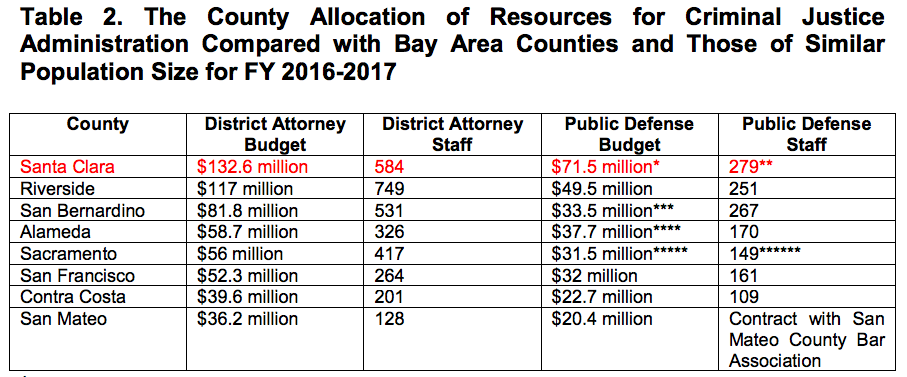Despite a low crime rate and plenty of public resources, Santa Clara County takes longer to resolve felony cases than any of its counterparts in California. In a report published last week, the county’s Civil Grand Jury found that the county resolved only 47 percent of its felony cases within a year.
The statewide rate? Eighty-eight percent.
Jurors blamed a pervasive “culture of complacency” for the delays, which come at a high cost to taxpayers by keeping people in jail longer than needed.
One-year felony resolution rates in other Bay Area counties run from 73 percent in San Francisco to 78 percent in Contra Costa, 84 percent in Alameda and 92 percent in San Mateo. That’s according to 2014 data compiled by the state Judicial Council.
The plodding pace of adjudication in Silicon Valley has given the region one of the highest incarceration rates in the state. According to the California Sentencing Initiative, 372 people per 1,000 adult felony arrestees are locked up in Santa Clara County. The California average is 247 per 1,000. Only Orange County locks up more people: 381 per for every 1,000.
Meanwhile, 74 percent of Santa Clara County are awaiting trial or settlement—that’s 10 percentage points higher than the state average.
There’s no reason to think that the South Bay deals with more scofflaws or less funding compared to other urban counties, the report states. In fact, Santa Clara County sees far less violent crime—2.5 for every 1,000 people—than neighboring jurisdictions, which come to 8.2 per 1,000 for San Francisco and 6.6 per 1,000 for Alameda.
 This county also spends much more money on far more people to staff its criminal justice system. It budgets about $133 million on a 584-person District Attorney’s Office and $71.5 million on a 279-person Public Defender’s Office and independent counsel.
This county also spends much more money on far more people to staff its criminal justice system. It budgets about $133 million on a 584-person District Attorney’s Office and $71.5 million on a 279-person Public Defender’s Office and independent counsel.
 The report—titled “Justice Delayed: Why Does It Take So Long to Resolve Felonies in Santa Clara County”—concludes that several causes factor into the inordinately prolonged felony resolution rate. Namely:
The report—titled “Justice Delayed: Why Does It Take So Long to Resolve Felonies in Santa Clara County”—concludes that several causes factor into the inordinately prolonged felony resolution rate. Namely:
Aggressive prosecution. Jurors found that the “price of milk,” that is the penalty for crime, is far higher in this county than elsewhere in California. That means prosecutors file multiple charges in a single case, which makes defendants leery of accepting a plea deal. “There is a history in the county of tough-on-crime district attorneys,” the report states. “The Grand Jury learned that some assistant district attorneys try for the maximum charges, regardless of mitigating circumstances.” Other sources told jurors that county residents used to low crime rates expect harsher penalties.
Holding out for better plea deals. About 99 percent of the county’s felony cases settle without a trial, but the process for reaching those agreements takes a lot of time, effort and trust. Defense attorneys often reject the initial offers from prosecutors because they need to gather or analyze more evidence, to investigate mitigating circumstances and to earn their client’s trust.
A dearth of defense lawyers. In cases with multiple defendants, each one is entitled to their own attorney to avoid conflicts of interest. When all but one defense attorney is ready for trial, however, that holds everyone else up. When information comes to light that exposes a conflict of interest and requires a defendant to find a new attorney, that also adds to the delay. The county recently upped the hourly rate for contract attorneys from $115 to $129 to expand the pool of available defense counsel for indigent clients.
Clerical and technological bottlenecks. A staffing shortage in the courts created a backlog of paperwork that kept inmates due for a state prison transfer in county jail for months longer than scheduled—all on the taxpayer’s dime. Complicating the matter are new technologies such as body cameras and social media postings, which have created a massive backlog of digital evidence to sift through. Any calls inmates make from jail must also be monitored. “It’s an enormous job to analyze all that potential evidence to fine the ‘one, two, 10 or 100’ calls that are relevant to the case,” jurors write. The county wants to update its software, but progress has been hard to come by. The DA is starting to transmit discovery materials digitally, but that’s still in the pilot stages. According to criminalists in the Santa Clara County Crime Laboratory, digital evidence accounts for the largest backlog because virtually every crime now involves a cellphone, at least.
Lag time on submitting evidence. The San Jose Police Department, which accounts for about 80 percent of serious criminal cases in the county, has struggled with staffing shortages that may have delayed its submission of evidence. The agency is filling its ranks now, thanks to more funding and better personnel benefits. But, the jurors note, more officers could either mean faster turnaround or more arrests and more cases.
Time-intensive forensic analysis. The Crime Lab prioritizes cases involving violent crimes and defendants deemed a threat to the public. Upon an arrest, a criminalist will ask the arresting officer what lab work they need and how urgently they need it done. If the police don’t verify whether evidence is still needed and attorneys don’t call to request it, the lab technicians put the analysis on hold.
“There is a good deal of finger pointing as to the cause of the delays,” the report states. “[P]rosecutors blame defenders for delaying tactics and vice versa.”
Changing the county’s slowest-in-the-state felony resolution rate will take a wide range of tactics, including alternatives to jail custody. The report acknowledges that a lot of the solutions will take years to realize, but the work can begin right now.
The document concludes with, “One thing can be done immediately: Begin to change the culture that has tolerated delayed justice.”
This article has been updated.


Where the report says Santa Clara County’s incarceration rate is 372, it means “per 1,000 adult felony arrestees” not per 1,000 “residents.” It also means “locked up in the County” (whether convicted or waiting for trial) and not in state prison or released on bail or due to insufficient evidence. That statistic is difficult to put in perspective.
The 74% of jail inmates awaiting trial is more stark. We thought county jail was for the guilty, but mostly it’s for the innocent until proven guilty.
You’re right about the “per adult felony arrestees.” Thanks for catching that. The article has been updated.
Obviously the solution to all this should be to stick it to the taxpayers, Right?
Maybe we should think about a 2 party solution!
Tired of waiting so long to get to trial? Don’t commit a crime.
But I’m innocent, and I want such a deal !
What’s that old saying the wheels of justice turn slowly. I was selected for jury duty and prepared to do my civic duty. There were tons of other people waiting for the selection process and in the end, my day was, I was excused. I thought what a colossal waste of money and time. Of course many people there had jobs and were probably relieved they do/did not have to serve. As for me, I have the time and would still be ready to serve. I would do it for nothing. In reading this article, statistics can be slanted in many ways and I would doubt many of these numbers. I would hope that the San Jose system has the power to separate cases that deal with more important crime and deal the lesser felonies out. Hell I hear of people being let out that should be in and stay in. Of course they are all innocent, we know that, and they all have a story to tell. Just tell that to the victims.